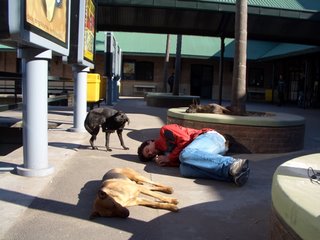Lighter Fare
As the account of my meal might suggest (see “Mi Casa es Tu Casa”), Argentine food is quite heavy. Digestion can be snake-like, requiring prolonged periods of complete inactivity.
A few days after my heart-stopping chivito encounter, I decided I needed to eat again, but wanted a change of pace.
Several people had told me about the restaurant of the Japanese Association, always with the same kind of description that make my eyes roll: “It’s where real Japanese people eat.”
I was wary, but the Asociación is right around the corner, so I decided to check things out. One door, closed, displayed flyers for language classes and Noh theater. The other door opened to a long hallway, at the end of which there was a gymnasium. People were practicing martial arts.
Exotic, but not edible.
I asked a security guard if in fact there was a restaurant, and he signaled to a pair of sliding doors with rice paper panes, which had until then escaped my attention.
I stepped inside and found myself in a very non-Argentine space: sushi bar, hanging red lanterns, and, to my mild surprise, real live Japanese people.
As an aside, I should let you know that many dry cleaners in Argentina have names like “Tintorería Tokio.” Surely there are Japanese immigrants and Nipo-Argentines in other professions, though dry cleaning is the most conspicuous one.
Buenos Aires is famously known as a city that turns its back to the sea. This is nowhere more obvious than on menus, where the seafood rarely strays beyond salmon, which is probably farmed in Chile to begin with.
In light of this fact, I ordered the sushi / sashimi combination platter. It was expensive (48 pesos), but well worth it.
A few days later I went back and had their lunch special. For 20 pesos, I had a big bowl of Udon, salad, a few sushi rolls, and rice.
All in all, a delicious respite from the local meat and pasta cuisine.






